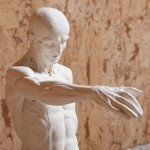 The Sculpture of the Ecorche (Leeds, 7 Jun 14)
The Sculpture of the Ecorche (Leeds, 7 Jun 14)
Henry Moore Institute, Leeds, June 7, 2014
Deadline: Feb 17, 2014
The Sculpture of the Écorché
Écorché represent the underlying musculature of the human figure, modelled in wax, carved in wood or cast in plaster or bronze for the purpose of anatomical instruction. This one-day conference takes the écorché as its subject, reconsidering the many ways in which it has been understood in relation to sculpture from the sixteenth century to the present day. We are interested in how the écorché has been variously seen and employed:as a teaching tool and as a model for the education of sculptorsas a scientific, three-dimensional demonstration modelin relation to the idealised forms of classical sculpture as sculpture in its own right, produced, reproduced and circulated in different forms as sculptural process and in relation to the figurative sculptural
imagination
The écorché has frequently operated across disciplinary boundaries and registers of respectability. Makers of wax écorchés in the eighteenth century, such as the Florentine Clemente Susini (1754-1814), were highly acclaimed during their lifetimes, with their work sought by prestigious collectors. For instance in 1781 the Holy Roman Emperor Joseph II commissioned Susini to make a collection for the Museum of the Medical University of Vienna. From 1799 Susini was engaged as a professor at the Accademia di Belle Arti in Florence, demonstrating the regard in which his work was held for the education of artists.
By the nineteenth century, however, wax came to be seen as a merely preparatory or even a disreputable medium for sculpture, with its capacity for forensic detail and mimetic reproduction of bone, muscle and skin operating against the prevailing neoclassical tendency towards ideal form. As a result of this change in taste, the écorché in plaster
of Paris, with both plain and coloured surfaces, became the primary teaching object for anatomical studies in European Academies and Schools of Art.
Papers are invited which draw out the relationships between sculpture and the écorché, looking at objects and makers from the sixteenth century onwards.
Please send a 250 word abstract and a short CV to Dr Rebecca Wade
(rebecca.wade@henry-moore.org) by 17 February 2014.

Leave a Reply
You must be logged in to post a comment.